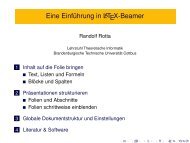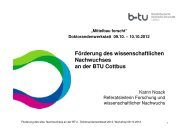Multilevel Graph Clustering with Density-Based Quality Measures
Multilevel Graph Clustering with Density-Based Quality Measures
Multilevel Graph Clustering with Density-Based Quality Measures
Create successful ePaper yourself
Turn your PDF publications into a flip-book with our unique Google optimized e-Paper software.
4 Evaluationadministrators, and graduate students. Two users are connected by an edge if bothexchanged e-mails <strong>with</strong> each other (Fig. 4.14b). Thus the graph is undirected andunweighted.In the last years also this graph became popular for the evaluation of graph clusteringmethods. The first published result is for Extremal Optimization. It found15 clusters and modularity 0.5738 [23]. Danon’s greedy joining <strong>with</strong> modified mergeselector just yielded modularity 0.5569 [17]. The recursive spectral bisection of Newmanfound a clustering <strong>with</strong> modularity 0.572 [58]. The best published clustering<strong>with</strong> modularity 0.579 was found by recursive bisection <strong>with</strong> Quadratic Programming[2]. The multi-level algorithm ML-KL-density produced 11 clusters <strong>with</strong> modularity0.57767. A better clustering <strong>with</strong> 9 clusters and modularity 0.58137 wasobtained from the random walk variant ML-KL-rw.hep-th main A scientist collaboration network in high-energy physics. The graphcontains the collaborations of scientists posting preprints on the high-energy theoryarchive at http://www.arxiv.org between 1995 and 1999. The 5835 vertices representauthors and edges connect co-authors. The edges are weighted as describedin [61].The only published clustering is from a recursive spectral bisection method. Itproduced 114 clusters <strong>with</strong> modularity 0.707 [21]. The multi-level algorithm ML-KL-density found 57 clusters of 0.85523. A better clustering was found <strong>with</strong> therandom-walk variant ML-KL-rw. It contains 59 clusters and has modularity 0.85629.Erdos02 This is the year 2002 version of the collaboration network around Erdös [34].The vertices represent authors and the unweighted edges connect co-authors. Onlyauthors <strong>with</strong> a co-author distance from Erdös up to 2 are included.The only published clustering was found <strong>with</strong> greedy joining combined <strong>with</strong> randomwalk based pre-coarsening. It contains 20 clusters and has modularity 0.6817 [65].The multi-level algorithm ML-KL-density produced 39 clusters <strong>with</strong> modularity0.71611. A slightly better clustering <strong>with</strong> the same number of clusters and modularity0.716396 was found by the random-walk variant ML-KL-rwPGPgiantcompo A giant component of the network of users of the Pretty-Good-Privacy algorithm for secure information interchange compiled by Arenas et al. [12,35]. The component contains 10680 vertices. Edges connect users trusting eachother.The modified greedy joining of Danon found the worst clustering <strong>with</strong> modularity0.7462 [17]. Extremal Optimization found 365 clusters <strong>with</strong> modularity 0.8459 [23].The best published modularity got Newman’s spectral bisection <strong>with</strong> 0.855 [58].The best of both multi-level algorithms was ML-KL-rw. It found 96 clusters <strong>with</strong>modularity 0.88462. The greedy grouping by density ML-KL-density yielded 102clusters <strong>with</strong> 0.88392. Finally the best clustering found in own experiments so farhas 94 clusters and modularity 0.885450.cond-mat-2003 main A collaboration network of scientists posting preprints onthe condensed matter archive at http://www.arxiv.org. This version contains data84






